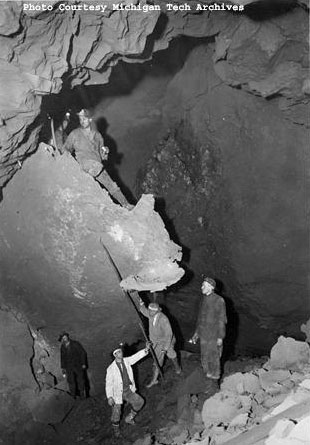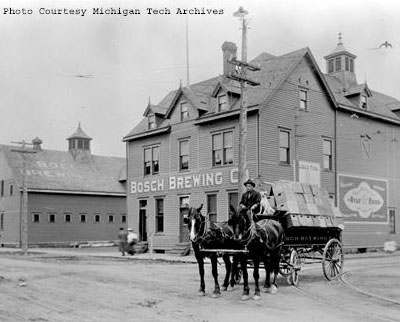|
Setting the Scene An Interior Ellis Island Keweenaw Ethnic
Groups |
This project is funded in part by Michigan Humanities Council, an affiliate of the National Endowment for the Humanities
|
Keweenaw
Ethnic Groups
~ The Germans~
Abstract•••I•••Article Contents•••I•••Further Reading•••I••Image Search•••I•••Source Notes
Abstract Germans were present in Michigan’s Copper Country from the start of modern extractive mining and, along with the Irish, Cornish and French Canadians, were among the large ethnic groups that dominated the Copper Country in its formative years. Germans who migrated to the Keweenaw Range were part of a much larger exodus from Germany. In the years between 1820 and 1900, nearly five million Germans immigrated to the United States, accounting for 15% of the total immigration into the United States (Germ 1). German immigration was not only great in numbers but also sustained over the entire nineteenth century. In no decade between 1830 and 1890 were the Germans ever less than a quarter of all immigrates into the United States and during the 1850s and 1860s, they constituted a third of all immigrants (Germ 2). It is therefore not surprising that by 1900, German immigrants and their descendents accounted for over 10% of the population of the United States (Germ 3), and at present 12% of Americans claim German ancestry, placing the ethnic group second only to those 14% claiming British ancestry (Germ 4). It must be remembered, however, that German unification did not occur until 1871 and Germans in America emigrated with, and retained, a high degree of regional identity. For example, German Protestants from Prussia were very different from German Catholics from Bavaria. With such regional diversity among German immigrants, it is difficult to construct a common history of German Americans (Germ 5). While some Germans emigrated to avoid compulsorily military service or for political reasons, such as the famous “48ers” who fled Germany after the failed revolution in 1848, the overwhelming majority of Germans who immigrated to the United States, as was the case for all immigrant groups, did so for economic reasons. Nineteenth-Century Germany experienced tremendous land pressure as rural overpopulation produced very high levels of surplus labor. Germany, of course, did industrialize but that industrialization was both geographically and chronologically uneven and did not produce enough employment for those who could no longer sustain themselves in agriculture. Many German farmers chose to immigrated to the United States, purchase land and remain in agriculture rather than migrating to a German industrial center as a wage laborer. Many such German farmers, as well as skilled craftsmen and small shopkeepers, seeking to maintain their traditional rural way of life, chose to move to rural America rather than to urban industrial Germany (Germ 6). Initially, the Germans provided a substantial proportion of the labor at the mines on the Keweenaw Peninsula, ranking forth in the number of laborers and third in the number of miners in 1870 (Germ 7). As was the case with the Cornish and Irish, the evidence suggests that the Germans arrived on the Keweenaw with previous mining experience. Circuit Court Judge Patrick H. O’Brien recalled that German miners distinguished themselves by wearing beautiful drilling clothes, which made them “look like Gods to the common miners,” and by their facility to plan out every exacting detail of mining (Germ 8). In addition to mining, Germans did most of the mechanical work at the mines (Germ 9). Many Germans left mining to pursue commercial interests on the Keweenaw and established a number of prominent businesses in brewing, construction, salon keeping, retail and hospitality. A Report of the Immigration Commission offers a statistical glimpse into the males of Copper Country’s foreign-born German community in 1909. The Report paints a portrait of an established and stable immigrant community. Eighty-five percent of the German immigrants had lived in the United States for 20 years or more and less than five percent had left the country since their initial immigration. As further evidence of the communities long-term nature, all of the German immigrants surveyed indicated that they were either citizens or had filled naturalization papers. Nine out of ten were 30 years or older and half were married. In contrast to the larger married male immigrant community in the Copper Country who had quarter of their wives living abroad, none of the Germans surveyed lived apart from their wives (Germ 10). Similar to all large immigrant communities in the Copper Country, Germans formed some thirty religious, cultural, fraternal, beneficial, charitable and social organizations to helped maintain community identity while simultaneously assisting with their transition into the larger American society. First among these German American organizations were mutual benefit societies that collected dues and served as an insurance pool to be extended to members in times of financial stress, such as an illness, an injury or death. Between 1859 and 1912, Germans in the Copper Country established eleven such societies. The Germania Society was active in Hancock from 1865, while the St. Joseph German Society, a Catholic benevolent society formed in Hancock in 1877. Branches of the Unterstuetzungs Verein were established in Hancock (1859), Houghton (1882), Tamarack City (1899), and Calumet (1912). The German Aid Society formed a group in Calumet in 1872, with chapters following in Hancock (1906), Lake Linden (1906) (Germ 11).
Copper County Germans also established numerous cultural and social organizations. As was the case with the larger German American community within the United States, the Order of the Sons of Herman (O.D.H.S) emerged during the nineteenth-century the most popular fraternal organization in the Copper Country. Hancock Germans establish the first such lodge in 1865, and over the next forty years, six additional lodges were established in Lake Linden, Houghton and Calumet. It was through fraternal organizations such as the Sons of Herman that German immigrants and their children located housing, found work, organized into political blocks and met their prospective mates. Another distinguishing feature of German America was its singing societies, or Mannerchor, and in the Copper Country, Houghton, Hancock and Calumet each established their own Mannerchor (Germ 12). Unlike some groups whose numbers in the Copper Country were disproportionate to their populations across the nation, German immigrant population on the Keweenaw more or less mirrored their percentage within the United States. In the decades between 1870 and 1890, the percentage of foreign-born Germans ranged from 17.5 to 10 percent in Houghton County (Germ 13). In the early twentieth century, German immigration to the Keweenaw appears to have remained relatively constant. In the five census enumerations from 1870 to 1910, the number of German immigrants in each enumeration ranged from 1,380 to 1,723(Germ 14). Even with the tremendous in-migration at the turn of the century, German immigrants as a percent of the foreign born population, continued to range in the narrow band between seven to five percent in the first four enumeration of the twentieth century, or the decades between 1900 and 1930(Germ 15). While the 1920 the US census found only 754 German immigrants in Houghton County, it appears that a large number of ethnic Germans remained throughout the twentieth century as the 2000 Census revealed that self-ascribed Germans are the second largest ethnic group in the Copper County. Hawgood, John Arkas. The Tragedy of German-America. New York: Arno Press, 1970. Kilar, Jeremy. Germans in Michigan. East Lansing: Michigan University Press, 2002. O’Connor, Richard. The German Americans. Boston: Little & Brown, 1968. Trommler, Frank and Joseph McVeigh, eds. America and
the Germans: An Assessment of a Three- Hundred-Year History.
Philadelphia: University of Pennsylvania Press, 1985. |
Copyright © 2004 - 2007
MTU Archives and Copper Country Historical Collections, J. Robert
Van Pelt Library, All Rights Reserved |



